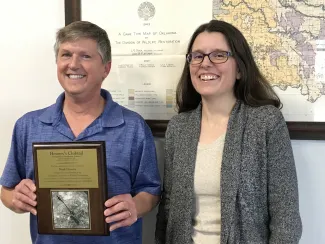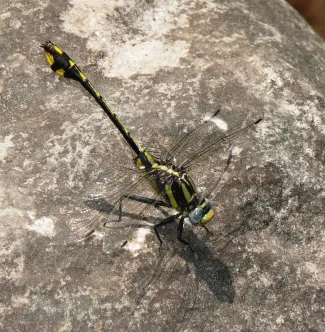Wildlife Department biologist Mark Howery was recently honored by Oklahoma Biological Survey staff with their announcement of a newly recognized dragonfly subspecies, the Howery’s clubtail. This isolated population of the Ozark clubtail was discovered in 2011 by Victor W. Fazio III along Salt Creek, a tributary of the Arkansas River, in western Osage County. It was later investigated by the Oklahoma Biological Survey’s conservation biologists Michael A. Patten and Brenda D. Smith.

Howery’s clubtail, a subspecies of the Ozark clubtail dragonfly, was recently investigated by Michael A. Patten and Brenda D. Smith (pictured right) and named for Wildlife Department biologist Mark Howery (pictured left).
“We’re pleased to name this new subspecies in honor of Mark Howery, for his decades of dedication and important contributions to conservation of nongame wildlife in the state of Oklahoma,” said Smith.
Howery has been a part of the Wildlife Department’s conservation efforts for the past 28 years, focusing on our state’s rare, declining and endangered species along with common species that aren’t hunted or fished.
"This is a tremendous honor for a biologist and I was shocked to be recognized this way," Howery said. "The Wildlife Department values the full breadth of the wildlife in our state and I am honored to be connected to a species that is unique to our region and that embodies the kind of proactive, collaborative conservation that we strive to achieve through the State Wildlife Grants program."
“This announcement really brings us full circle. Michael A. Patten and I started this journey with a survey funded by the Wildlife Department’s State Wildlife Grants Program. Mark has been so supportive of our work that it felt right to recognize him in this way,” Smith said.
Patten and Smith were awarded the State Wildlife Grant in 2013 to conduct a three-year survey to determine the status, distribution and ecology of three springtime-emerging dragonflies considered to be of greatest conservation need, including the Ozark clubtail. The completed survey effectively doubled the number of known records of the target species, adding dozens of localities of occurrence. Patten and Smith also documented other dragonfly species found at their 281 survey sites and made recommendations for dragonfly conservation. The survey was funded in part by the Wildlife Department and U.S. Fish and Wildlife Service’s State Wildlife Grant F13AF01188 and by the Oklahoma Biological Survey, University of Oklahoma. The survey’s final report can be found at wildlifedepartment.com.
The Oklahoma Biological Survey also thanks Victor W. Fazio III for his field expertise and energy which led to the discovery of the isolated population in the Osage Hills of Oklahoma.
About Howery's Clubtail

The newly described Howery’s clubtail subspecies (Gomphurus ozarkensis howeryi) can be distinguished from the Ozark clubtail (Gomphurus ozarkensis) most easily by its slightly larger size and differences in coloration on the ninth segment of the abdomen and on the thorax. As a whole, the Ozark clubtail is a relatively new species, first described in 1975, and is thought to primarily occur in the Ozark Plateau and Ouachita highlands of Arkansas, Kansas, Missouri, and Oklahoma.
The Howery’s clubtail population is only separated from the nominate Ozark clubtail population by about 30 miles but the localities are divided by substantial topography and are part of different watersheds. This means the streams in which the dragonflies lay their eggs are not connected and the larvae never intermingle.
Learn more about Oklahoma’s 176 species of dragonflies and damselflies in Smith and Patten’s new book “Dragonflies at a Biogeographical Crossroads: the Odonata of Oklahoma and Complexities Beyond its Borders.” The book is planned for release in mid-June.
Dragonflies and damselflies are also featured in the current issue of the Wildlife Department’s magazine, Outdoor Oklahoma. The issue’s photo-essay by Bryan Reynolds shares details of Odonate life and gives a peek into Oklahoma’s incredible dragonfly and damselfly diversity. Annual subscriptions to Outdoor Oklahoma are available for $10.